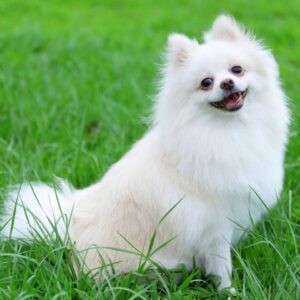The Pomeranian: Lively Charm in a Petite Package
Introduction:
The Pomeranian, a small and spirited toy breed, is celebrated for its vivacious personality, luxurious coat, and endearing charm. Originating from the Pomerania region in present-day Poland and Germany, Pomeranians have captivated dog enthusiasts with their delightful demeanor and royal connections. In this article, we will explore the history, characteristics, temperament, care requirements, and notable contributions of the Pomeranian.
History:
The Pomeranian’s roots can be traced back to larger sled-pulling and working Spitz-type dogs in the Arctic regions. Over time, these dogs were selectively bred to a smaller size in the Pomerania region, leading to the development of the modern Pomeranian. Notable historical figures, including Queen Victoria of England, played a role in popularizing the breed during the 19th century.
The American Kennel Club (AKC) officially recognized the Pomeranian in 1900, and since then, it has become a beloved companion, often adored for its lively personality and striking appearance.
Physical Characteristics:
1. **Size:**
– Height: 6 to 7 inches at the shoulder
– Weight: 3 to 7 pounds
2. **Build:**
– Compact and well-proportioned with a foxy expression
– Small, erect ears, and a plume-like tail carried over the back
– Profuse double coat with a dense undercoat and a long, straight outer coat
3. **Coat:**
– Various coat colors, including orange, black, chocolate, cream, blue, sable, and more
– Plume-like tail carried over the back
Temperament:
Pomeranians are known for their lively and extroverted temperament. Despite their small size, they are often described as confident, bold, and assertive. Pomeranians are typically affectionate with their families and can be outgoing and social with proper socialization.
While their spirited nature may lead to occasional bouts of stubbornness, Pomeranians are generally intelligent and respond well to positive reinforcement-based training. They form strong bonds with their human companions and thrive on attention and play.
Care Requirements:
1. **Exercise:**
– Pomeranians have moderate exercise needs. Daily walks, playtime, and interactive toys are important to keep them mentally stimulated and physically active. Due to their small size, they adapt well to indoor living.
2. **Grooming:**
– Pomeranians have a profuse double coat that requires regular grooming. Daily brushing helps prevent matting and tangling, and regular attention to dental care, ear cleaning, and nail trimming is important for overall health.
3. **Training:**
– Positive reinforcement-based training methods work well with Pomeranians. Early socialization is crucial to ensure they are well-behaved and comfortable in various situations. Housetraining may require consistency and patience.
4. **Nutrition:**
– Providing a well-balanced and nutritious diet is crucial for the overall health of Pomeranians. Due to their small size, it’s important to monitor their weight and feed them a diet appropriate for their life stage. Consultation with a veterinarian can help determine the best dietary plan.
Notable Contributions:
While Pomeranians may not have specific working roles like larger breeds, their delightful personalities have made them popular in various forms of media, including films and advertisements. Their small size and portable nature make them ideal companions for people in various living situations.
Conclusion:
The Pomeranian, with its lively charm and petite frame, continues to capture the hearts of dog enthusiasts worldwide. Whether prancing at dog shows, starring in films, or providing joyful companionship at home, the Pomeranian’s spirited personality and regal appearance make it a cherished member of the toy dog group.


Leave a Reply